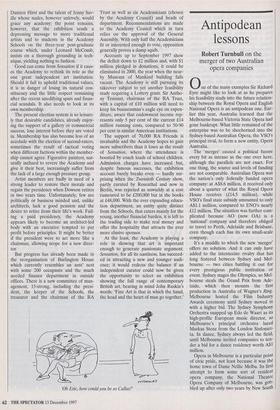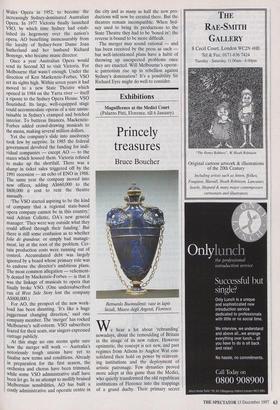Antipodean lessons
Robert Turnbull on the merger of two Australian opera companies 0 ne of the many examples Sir Richard Eyre might like to look at as he prepares his feasibility study into the future relation- ship between the Royal Opera and English National Opera is an antipodean one. Ear- lier this year, Australia learned that the Melbourne-based Victoria State Opera had gone bankrupt. What little remained of the enterprise was to be shoehorned into the Sydney-based Australian Opera, the VSO's principal rival, to form a new entity, Opera Australia.
The 'merger' caused a political furore every bit as intense as the one over here, although the parallels are not exact. For one thing, the source and levels of funding are not comparable. Australian Opera was the nation's only federally funded opera company: at A$8.6 million, it received only about a quarter of what the Royal Opera House receives (£14.5 million), while VSO's final state subsidy amounted to only A$1.1 million, compared to ENO's nearly £12 million. The situation was further com- plicated because AO (now OA) is a 'national' company and therefore obliged to travel to Perth, Adelaide and Brisbane, even though each has its own small-scale company.
It's a muddle to which the new 'merger' offers no solution. And it can only have added to the internecine rivalry that has long festered between Sydney and Mel- bourne — two cities battling it out for every prestigious public institution or event. Sydney stages the Olympics, so Mel- bourne steals the Grand Prix from Ade- laide, which then mounts the first production in Australia of Wagner's Ring. Melbourne hosted the Film Industry Awards ceremony until Sydney moved in with a higher bid. The Sydney Symphony Orchestra snapped up Edo de Waart as its high-profile European music director, so Melbourne's principal orchestra lured Markus Stenz from the London Sinfoniet- ta. In dance, Sydney always led the field, until Melbourne invited companies to ten- der a bid for a dance residency worth A$1 million.
Opera in Melbourne is a particular point of civic pride, not least because it was the home town of Dame Nellie Melba. Its first attempt to form some sort of resident opera company, the National Theatre Opera Company of Melbourne, was gob- bled up after only two years by New South Wales Opera in 1952, to become the increasingly Sydney-dominated Australian Opera. In 1977 Victoria finally launched VSO, by which time Sydney had estab- lished its hegemony over the nation's Opera, AO benefiting immeasurably from the loyalty of Sydney-born Dame Joan Sutherland and her husband Richard 13onynge, who became music director.
Once a year Australian Opera would send its Second XI to visit Victoria. For Melbourne that wasn't enough. Under the direction of Ken Mackenzie-Forbes, VSO set its sights high. Within seven years it had moved to a new State Theatre which Opened in 1984 on the Yarra river — itself a riposte to the Sydney Opera House. VSO flourished. Its large, well-equipped stage could accommodate operas of a size unsus- tainable in Sydney's cramped and botched interior. To buttress finances, Mackenzie- Forbes added crowd-drawing musicals to the menu, making several million dollars.
Yet the company's slide into insolvency took few by surprise. In 1985 the federal government devolved the funding for indi- vidual companies — except AO — to the states which housed them. Victoria refused to make up the shortfall. There was a slump in ticket sales triggered off by the 1991 recession — an echo of ENO in 1988. The same year the company moved into new offices, adding A$660,000 to the $800,000 it cost to rent the theatre annually.
The VSO started aspiring to be the kind of company that a regional state-based opera company cannot be in this country,' said Adrian Collette, OA's new general manager. 'They were way outside what they could afford through their funding.' But there is still some confusion as to whether folie de grandeur, or simply bad manage- ment, lay at the root of the problem. Cer- tain production costs were running out of control. Accumulated debt was largely ignored by a board whose primary role was to endorse the director's ambitious plans. The most common allegation — vehement- ly denied by Mackenzie-Forbes — is that it was the linkage of musicals to opera that finally broke VSO. (One undersubscribed run of West Side Stoiy lost the company A$800,000.) For AO, the prospect of the new work- load has been daunting. It's like a huge Juggernaut changing direction,' said one company member. The 'merger' has rocked Melbourne's self-esteem. VSO subscribers feared for their seats, star singers expressed outrage publicly.
At this stage no one seems quite sure how the merger will work — Australia's notoriously tough unions have yet to finalise new terms and conditions. Already in preparation for the first season, the orchestra and chorus have been trimmed, While some VSO administrative staff have been let go. In an attempt to mollify bruised Melbornian sensibilities, AO has built a costly administrative and operatic centre in the city and as many as half the new pro- ductions will now be created there. But the theatres remain incompatible. When Syd- ney used to bring its productions to the State Theatre they had to be 'boxed in'; the reverse is bound to be more difficult.
The merger may sound rational — and has been received by the press as such — but well-intentioned plans have a habit of throwing up unexpected problems once they are enacted. Will Melbourne's operat- ic patriotism rise up in rebellion against Sydney's domination? It's a possibility Sir Richard Eyre might do well to consider.



















































































 Previous page
Previous page